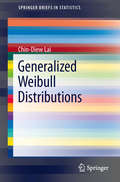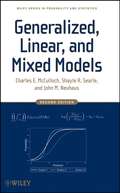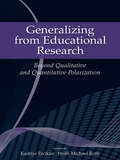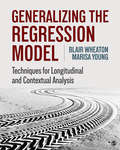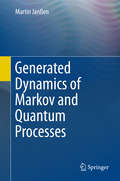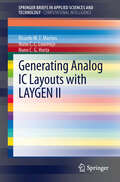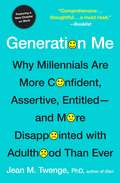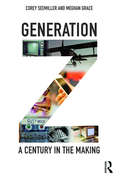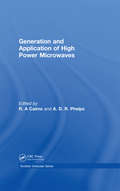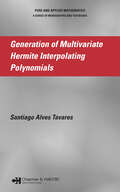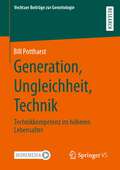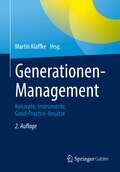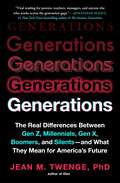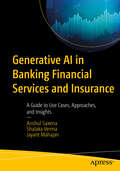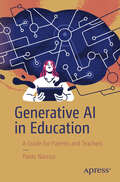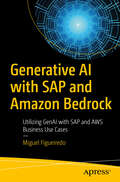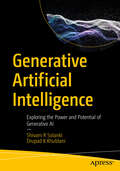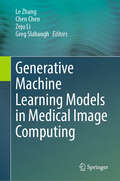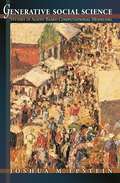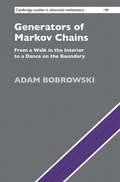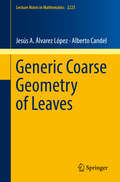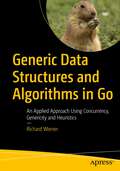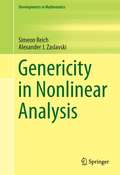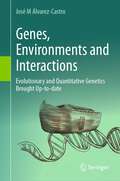- Table View
- List View
Generalized Weibull Distributions
by Chin-Diew LaiThe Weibull distribution has been one of the most cited lifetime distributions in reliability engineering. Over the last decade, many generalizations and extensions of the Weibull have been proposed in order to provide more flexibility than the traditional version when it comes to modeling lifetime data in diverse fields. This book offers an update on these developments, presenting the essential properties of each model. Several plots of density and hazard rate functions are also included, and a brief outline of known application(s) for each model is also given.
Generalized, Linear, and Mixed Models (Wiley Series in Probability and Statistics #651)
by John M. Neuhaus Shayle R. Searle Charles E. McCullochAn accessible and self-contained introduction to statistical models-now in a modernized new edition Generalized, Linear, and Mixed Models, Second Edition provides an up-to-date treatment of the essential techniques for developing and applying a wide variety of statistical models. The book presents thorough and unified coverage of the theory behind generalized, linear, and mixed models and highlights their similarities and differences in various construction, application, and computational aspects. A clear introduction to the basic ideas of fixed effects models, random effects models, and mixed models is maintained throughout, and each chapter illustrates how these models are applicable in a wide array of contexts. In addition, a discussion of general methods for the analysis of such models is presented with an emphasis on the method of maximum likelihood for the estimation of parameters. The authors also provide comprehensive coverage of the latest statistical models for correlated, non-normally distributed data. Thoroughly updated to reflect the latest developments in the field, the Second Edition features: A new chapter that covers omitted covariates, incorrect random effects distribution, correlation of covariates and random effects, and robust variance estimation A new chapter that treats shared random effects models, latent class models, and properties of models A revised chapter on longitudinal data, which now includes a discussion of generalized linear models, modern advances in longitudinal data analysis, and the use between and within covariate decompositions Expanded coverage of marginal versus conditional models Numerous new and updated examples With its accessible style and wealth of illustrative exercises, Generalized, Linear, and Mixed Models, Second Edition is an ideal book for courses on generalized linear and mixed models at the upper-undergraduate and beginning-graduate levels. It also serves as a valuable reference for applied statisticians, industrial practitioners, and researchers.
Generalizing from Educational Research: Beyond Qualitative and Quantitative Polarization
by Kadriye Ercikan Wolff-Michael Roth"This book frames the major challenge facing educational researchers as one of going beyond the mindless qualitative-quantitative divide and addressing the overarching/fundamental challenge of enriching and enlarging educational inquiry. It is a signature contribution to the field." - Clifton F. Conrad, University of Wisconsin-Madison, USA Tackling one of the most critical issues in education research today - how research methods are related to value and meaningfulness - this frontline volume achieves two purposes. First, it presents an integrated approach to educational inquiry that works toward a continuum instead of a dichotomy of generalizability, and looks at how this continuum might be related to types of research questions asked and how these questions should determine modes of inquiry. Second, it discusses and demonstrates the contributions of different data types and modes of research to generalizability of research findings, and to limitations of research findings that utilize a single approach. International leaders in the field take the discussion of generalizing in education research to a level where claims are supported using multiple types of evidence. The volume pushes the field in a different direction, where the focus is on creating meaningful research findings that are not polarized by qualitative versus quantitative methodologies. The integrative approach allows readers to better understand possibilities and shortcomings of different types of research.
Generalizing the Regression Model: Techniques for Longitudinal and Contextual Analysis
by Blair Wheaton Marisa YoungThis comprehensive text introduces regression, the general linear model, structural equation modeling, the hierarchical linear model, growth curve models, panel data, and event history models, and includes discussion of published implementations of each technique showing how it was used to address substantive and interesting research questions. It takes a step-by-step approach in the presentation of each topic, using mathematical derivations where necessary, but primarily emphasizing how the methods involved can be implemented, are used in addressing representative substantive problems than span a number of disciplines, and can be interpreted in words. The book demonstrates the analyses in STATA and SAS. Generalizing the Regression Model provides students with a bridge from the classroom to actual research practice and application. A website for the book at https://edge.sagepub.com/wheaton1e (coming soon!) includes resources for instructors and students.
Generalizing the Regression Model: Techniques for Longitudinal and Contextual Analysis
by Blair Wheaton Marisa YoungThis comprehensive text introduces regression, the general linear model, structural equation modeling, the hierarchical linear model, growth curve models, panel data, and event history models, and includes discussion of published implementations of each technique showing how it was used to address substantive and interesting research questions. It takes a step-by-step approach in the presentation of each topic, using mathematical derivations where necessary, but primarily emphasizing how the methods involved can be implemented, are used in addressing representative substantive problems than span a number of disciplines, and can be interpreted in words. The book demonstrates the analyses in STATA and SAS. Generalizing the Regression Model provides students with a bridge from the classroom to actual research practice and application. A website for the book at https://edge.sagepub.com/wheaton1e (coming soon!) includes resources for instructors and students.
Generated Dynamics of Markov and Quantum Processes
by Martin JanßenThis book presents Markov and quantum processes as twosides of a coin called generated stochastic processes. It deals withquantum processes as reversible stochastic processes generated byone-step unitary operators, while Markov processes are irreversible stochasticprocesses generated by one-step stochastic operators. The characteristicfeature of quantum processes are oscillations, interference, lots of stationarystates in bounded systems and possible asymptotic stationary scattering statesin open systems, while the characteristic feature of Markov processes arerelaxations to a single stationary state. Quantum processes apply to systemswhere all variables, that control reversibility, are taken as relevantvariables, while Markov processes emerge when some of those variables cannot befollowed and are thus irrelevant for the dynamic description. Their absencerenders the dynamic irreversible. Afurther aim is to demonstrate that almost any subdiscipline of theoretical physicscan conceptually be put into the context of generated stochastic processes. Classical mechanics and classical field theory are deterministic processeswhich emerge when fluctuations in relevant variables are negligible. Quantummechanics and quantum field theory consider genuine quantum processes. Equilibrium and non-equilibrium statistics apply to the regime where relaxingMarkov processes emerge from quantum processes by omission of a large number ofuncontrollable variables. Systems with many variables often self-organize insuch a way that only a few slow variables can serve as relevant variables. Symmetries and topological classes are essential in identifying such relevantvariables. Thethird aim of this book is to provide conceptually general methods of solutionswhich can serve as starting points to find relevant variables as to apply best-practice approximation methods. Such methods are available through generatingfunctionals. The potential reader is a graduate student whohas heard already a course in quantum theory and equilibrium statisticalphysics including the mathematics of spectral analysis (eigenvalues,eigenvectors, Fourier and Laplace transformation). The reader should be openfor a unifying look on several topics.
Generating Analog IC Layouts with LAYGEN II
by Nuno C.G. Horta Nuno C. Lourenço Ricardo M. MartinsThis book presents an innovative methodology for the automatic generation of analog integrated circuits (ICs) layout, based on template descriptions and on evolutionary computational techniques. A design automation tool, LAYGEN II was implemented to validate the proposed approach giving special emphasis to reusability of expert design knowledge and to efficiency on retargeting operations.
Generation Me - Revised and Updated: Why Today's Young Americans Are More Confident, Assertive, Entitled--and More Miserable Than Ever Before
by Ph.D. Jean M. TwengeThe Associated Press calls them "The Entitlement Generation," and they are storming into schools, colleges, and businesses all over the country. They are today's young people, a new generation with sky-high expectations and a need for constant praise and fulfillment. In this provocative new book, headline-making psychologist and social commentator Dr. Jean Twenge documents the self-focus of what she calls "Generation Me" -- people born in the 1970s, 1980s, and 1990s. Herself a member of Generation Me, Dr. Twenge explores why her generation is tolerant, confident, open-minded, and ambitious but also cynical, depressed, lonely, and anxious. Using findings from the largest intergenerational study ever conducted -- with data from 1.3 million respondents spanning six decades -- Dr. Twenge reveals how profoundly different today's young adults are -- and makes controversial predictions about what the future holds for them and society as a whole. But Dr. Twenge doesn't just talk statistics -- she highlights real-life people and stories and vividly brings to life the hopes and dreams, disappointments and challenges of Generation Me.With a good deal of irony, humor, and sympathy she demonstrates that today's young people have been raised to aim for the stars at a time when it is more difficult than ever to get into college, find a good job, and afford a house -- even with two incomes. GenMe's expectations have been raised just as the world is becoming more competitive, creating an enormous clash between expectations and reality. Dr. Twenge also presents the often-shocking truths about her generation's dramatically different sexual behavior and mores. GenMe has created a profound shift in the American character, changing what it means to be an individual in today's society. Engaging, controversial, prescriptive, and often funny, Generation Me will give Boomers new insight into their offspring, and help GenMe'ers in their teens, 20s, and 30s finally make sense of themselves and their goals and find their road to happiness.
Generation Z: A Century in the Making
by Corey Seemiller Meghan GraceNo other generation in history has received as much coverage as the Millennial generation. Books, Google searches, blogs, and news articles are everywhere about them. Yet, Generation Z is comprised of our youth and young adults today and has received very little attention comparatively. Those in Generation Z are among our youngest consumers, students, colleagues, constituents, voters, and neighbors. Being able to better understand who they are and how they see the world can be helpful in effectively working with, teaching, supervising, and leading them. Generation Z: A Century in the Making offers insight into nearly every aspect of the lives of those in Generation Z, including a focus on their career aspirations, religious beliefs and practices, entertainment and hobbies, social concerns, relationships with friends and family, health and wellness, money management, civic engagement, communication styles, political ideologies, technology use, and educational preferences. Drawing from an unprecedented number of studies with higher education research institutions, market research firms such as Pew and Census, other generational researchers and industry leaders, this is the authoritative defining work on Generation Z that market researchers, consumer behaviour specialists, and employers sorely need – and it is a fascinating read for anyone interested in the sociology of generations.
Generation and Application of High Power Microwaves
by P Osborne R A Cairns A D R PhelpsWritten at the graduate level, Generation and Application of High Power Microwaves discusses the basic physics of the generation of microwave and radiofrequency waves in the megawatt power range and the application of these ideas to a range of devices such as klystrons, gyrotrons, and free electron lasers. The book also contains chapters covering the transmission of the power through waveguides and the problems associated with mode conversion in transmission lines. The main application area covered is the heating and current drive in tokamaks and other devices for research into controlled nuclear fusion. Other applications of high power microwave technology are not neglected, and among those discussed are multiple charged ion and soft x-ray sources, electron spin resonance spectroscopy, advanced materials processing, millimeter wave radar, and supercolliders.
Generation of Multivariate Hermite Interpolating Polynomials
by Santiago Alves TavaresThis text advances the study of approximate solutions to partial differential equations by formulating a novel approach that employs Hermite interpolating polynomials and by supplying algorithms useful in applying this approach. The book's three sections examine constrained numbers, Hermite interpolating polynomials, and selected applications. The authors outline the rules for writing the algorithms and then present them in pseudo-code. Next, they define the properties that characterize the Hermite interpolating polynomials, propose an expression and demonstrate an algorithm for generating the polynomials, and show the advantages of this new technique over the classical approach.
Generation, Ungleichheit, Technik: Technikkompetenz im höheren Lebensalter (Vechtaer Beiträge zur Gerontologie)
by Bill PottharstIn diesem Buch wird versucht, die Theorieansätze der Technikgenerationen mit jenen der sozialen Ungleichheit auf eine Weise zu verbinden, dass Rückschlüsse auf die Technikakzeptanz, die Technikkompetenz und die Techniknutzung im höheren Lebensalter abgeleitet werden können. Technikroutinen werden im höheren Lebensalter insbesondere durch Prägungen im Lebensverlauf und die soziale Lage in der aktuellen Lebenssituation bestimmt. Unerlässlich scheint, älteren Menschen Zugang zu neuen Technologien zu ermöglichen, ihnen jedoch ebenso genügend Freiraum dafür einzuräumen, auf den Einsatz ungewollter Technologien verzichten zu können.
Generationen-Management: Konzepte, Instrumente, Good-Practice-Ansätze
by Martin KlaffkeDer demografische Wandel führt nicht nur zu einem Rückgang der Erwerbsbevölkerung, sondern auch zu neuen Ansprüchen und Vorstellungen der Beschäftigten im Arbeitsleben. Dessen ungeachtet setzen Arbeitgeber ihre Prioritäten beim Demografie-Management noch überwiegend in den Bereichen Gesundheitsförderung und Nachwuchsgewinnung. Dies reicht jedoch nicht aus, um in digitalen Zeiten eine wettbewerbsfähige Belegschaft aufzubauen. Denn für die Zukunftsfähigkeit von Unternehmen kommt es neben der Arbeitsfähigkeit vor allem auf die Kooperationsbereitschaft und das Engagement der Mitarbeitenden jeden Alters an.Generationen-Management steigert die Arbeitgeberattraktivität und nutzt das Potenzial altersgemischter Belegschaften nachhaltig zum Vorteil von Beschäftigten und Unternehmen. Hierbei sind drei Handlungsfelder wesentlich: die organisationalen und arbeitspolitischen Rahmenbedingungen gestalten, die lebenslange Leistungsfähigkeit fördern und die intergenerative Wertschätzung und Zusammenarbeit stärken. Mit umfangreichen Praxis-Tipps zeigen Expertinnen und Experten auf, wie Arbeitgeber die Fähigkeit zum Management einer Mehr-Generationen-Belegschaft gezielt entwickeln und sich einen handfesten Wettbewerbsvorteil erarbeiten können
Generations: The Real Differences Between Gen Z, Millennials, Gen X, Boomers, and Silents—and What They Mean for America's Future
by Jean M. TwengeA groundbreaking, &“lavishly informative&” (The New York Times) portrait of the six generations that currently live in the United States and how they connect, conflict, and compete with one another—from the acclaimed author of Generation Me and iGen.Upending the conventional theory that generational differences are caused by major events, Dr. Jean Twenge analyzes data on 39 million people from robust national surveys—some going back nearly a century—to show that changes in technology are the underlying driver of each generation&’s unique makeup. In this revelatory work, Twenge outlines key shifts in attitudes and lifestyle choices that define each generation regarding gender, income, politics, race, sexuality, marriage, mental health, and much more. Surprising, engaging, and informative, Generations &“gets you thinking about how appreciating generational differences can, ironically, bring us together&” (Angela Duckworth, New York Times bestselling author). It will forever change the way you view your parents, peers, coworkers, and children, no matter which generation you call your own.
Generative AI in Banking Financial Services and Insurance: A Guide to Use Cases, Approaches, and Insights
by Anshul Saxena Shalaka Verma Jayant MahajanThis book explores the integration of Generative AI within the Banking, Financial Services, and Insurance (BFSI) sector, elucidating its implications, applications, and the future landscape of BFSI. The first part delves into the origins and evolution of Generative AI, providing insights into its mechanics and applications within the BFSI context. It goes into the core technologies behind Generative AI, emphasizing their significance and practical applications. The second part explores how Generative AI intersects with core banking processes, ranging from transactional activities to customer support, credit assessment, and regulatory compliance. It focuses on the digital transformation driving investment banking into the future. It also discusses AI’s role in algorithmic trading, client interactions, and regulatory adaptations. It analyzes AI-driven techniques in portfolio management, customer-centric solutions, and the next-generation approach to financial planning and advisory matters. The third part equips you with a structured roadmap for AI adoption in BFSI, highlighting the steps and the challenges. It outlines clear steps to assist BFSI institutions in incorporating Generative AI into their operations. It also raises awareness about the moral implications associated with AI in the BFSI sector. By the end of this book you will understand Generative AI’s present and future role in the BFSI sector. What You Will Learn Know what Generative AI is and its applications in the BFSI sector Understand deep learning and its significance in generative models Analyze the AI-driven techniques in portfolio management and customer-centric solutions Know the future of investment banking and trading with AI Know the challenges of integrating AI into the BFSI sector Who This Book Is For Professionals in the BFSI and IT sectors, including system administrators and programmers
Generative AI in Education: A Guide for Parents and Teachers
by Paolo NarcisoAs artificial intelligence (AI) rapidly transforms education, tools like ChatGPT and Claude are revolutionizing the way we teach and learn. This book is a groundbreaking book that empowers parents and students to navigate this exciting new frontier, filling a critical gap in the current literature. As the first comprehensive guide to generative AI in education designed for parents and students, Generative AI in Education is positioned to become an indispensable resource. It provides the knowledge and strategies needed to effectively integrate AI into their learning journeys, transforming educational outcomes and preparing students for success in a rapidly changing world. You’ll gain a deep understanding of how tools like ChatGPT and Claude work, and how they can be leveraged to support learning across various subjects and grade levels. You’ll then see how to create clear, specific, and engaging prompts that elicit valuable responses from AI-powered tools. This book contains all the techniques for tailoring prompts to different learning objectives, styles, and contexts, and how they can use AI tools to support reading comprehension, writing skills, problem-solving, and creative thinking. What You Will Learn Apply generative AI in education Craft effective prompts for personalized learning experiences Utilize AI tools to support learning, creativity, and problem-solving Who This Book is For Parents and students who are eager to harness the power of generative AI to enhance learning experiences and prepare for success in an AI-driven future
Generative AI with SAP and Amazon Bedrock: Utilizing GenAI with SAP and AWS Business Use Cases
by Miguel FigueiredoExplore Generative AI and understand its key concepts, architecture, and tangible business use cases. This book will help you develop the skills needed to use SAP AI Core service features available in the SAP Business Technology Platform. You’ll examine large language model (LLM) concepts and gain the practical knowledge to unleash the best use of Gen AI. As you progress, you’ll learn how to get started with your own LLM models and work with Generative AI use cases. Additionally, you’ll see how to take advantage Amazon Bedrock stack using AWS SDK for ABAP. To fully leverage your knowledge, Generative AI with SAP and Amazon Bedrock offers practical step-by-step instructions for how to establish a cloud SAP BTP account model and create your first GenAIartifacts. This work is an important prerequisite for those who want to take full advantage of generative AI with SAP. What You Will Learn Master the concepts and terminology of artificial intelligence and GenAI Understand opportunities and impacts for different industries with GenAI Become familiar with SAP AI Core, Amazon Bedrock, AWS SDK for ABAP and develop your firsts GenAI projects Accelerate your development skills Gain more productivity and time implementing GenAI use cases Who this Book Is For Anyone who wants to learn about Generative AI for Enterprise and SAP practitioners who want to take advantage of AI within the SAP ecosystem to support their systems and workflows.
Generative Artificial Intelligence: Exploring the Power and Potential of Generative AI
by Shivam R Solanki Drupad K KhublaniThis book explains the field of Generative Artificial Intelligence (AI), focusing on its potential and applications, and aims to provide you with an understanding of the underlying principles, techniques, and practical use cases of Generative AI models. The book begins with an introduction to the foundations of Generative AI, including an overview of the field, its evolution, and its significance in today’s AI landscape. It focuses on generative visual models, exploring the exciting field of transforming text into images and videos. A chapter covering text-to-video generation provides insights into synthesizing videos from textual descriptions, opening up new possibilities for creative content generation. A chapter covers generative audio models and prompt-to-audio synthesis using Text-to-Speech (TTS) techniques. Then the book switch gears to dive into generative text models, exploring the concepts of Large Language Models (LLMs), natural language generation (NLG), fine-tuning, prompt tuning, and reinforcement learning. The book explores techniques for fixing LLMs and making them grounded and indestructible, along with practical applications in enterprise-grade applications such as question answering, summarization, and knowledge-based generation. By the end of this book, you will understand Generative text, and audio and visual models, and have the knowledge and tools necessary to harness the creative and transformative capabilities of Generative AI. What You Will Learn What is Generative Artificial Intelligence? What are text-to-image synthesis techniques and conditional image generation? What is prompt-to-audio synthesis using Text-to-Speech (TTS) techniques? What are text-to-video models and how do you tune them? What are large language models, and how do you tune them? Who This Book Is For Those with intermediate to advanced technical knowledge in artificial intelligence and machine learning
Generative Machine Learning Models in Medical Image Computing
by Chen Chen Le Zhang Zeju Li Greg SlabaughGenerative Machine Learning Models in Medical Image Computing" provides a comprehensive exploration of generative modeling techniques tailored to the unique demands of medical imaging. This book presents an in-depth overview of cutting-edge generative models such as GANs, VAEs, and diffusion models, examining how they enable groundbreaking applications in medical image synthesis, reconstruction, and enhancement. Covering diverse imaging modalities like MRI, CT, and ultrasound, it illustrates how these models facilitate improvements in image quality, support data augmentation for scarce datasets, and create new avenues for predictive diagnostics. Beyond technical details, the book addresses critical challenges in deploying generative models for healthcare, including ethical concerns, interpretability, and clinical validation. With a strong focus on real-world applications, it includes case studies and implementation guidelines, guiding readers in translating theory into practice. By addressing model robustness, reproducibility, and clinical utility, this book is an essential resource for researchers, clinicians, and data scientists seeking to leverage generative models to enhance biomedical imaging and deliver impactful healthcare solutions. Combining technical rigor with practical insights, it offers a roadmap for integrating advanced generative approaches in the field of medical image computing.
Generative Social Science: Studies in Agent-Based Computational Modeling (Princeton Studies in Complexity #21)
by Joshua M. EpsteinAgent-based computational modeling is changing the face of social science. In Generative Social Science, Joshua Epstein argues that this powerful, novel technique permits the social sciences to meet a fundamentally new standard of explanation, in which one "grows" the phenomenon of interest in an artificial society of interacting agents: heterogeneous, boundedly rational actors, represented as mathematical or software objects. After elaborating this notion of generative explanation in a pair of overarching foundational chapters, Epstein illustrates it with examples chosen from such far-flung fields as archaeology, civil conflict, the evolution of norms, epidemiology, retirement economics, spatial games, and organizational adaptation. In elegant chapter preludes, he explains how these widely diverse modeling studies support his sweeping case for generative explanation.This book represents a powerful consolidation of Epstein's interdisciplinary research activities in the decade since the publication of his and Robert Axtell's landmark volume, Growing Artificial Societies. Beautifully illustrated, Generative Social Science includes a CD that contains animated movies of core model runs, and programs allowing users to easily change assumptions and explore models, making it an invaluable text for courses in modeling at all levels.
Generators of Markov Chains: From a Walk in the Interior to a Dance on the Boundary (Cambridge Studies in Advanced Mathematics #190)
by Adam BobrowskiElementary treatments of Markov chains, especially those devoted to discrete-time and finite state-space theory, leave the impression that everything is smooth and easy to understand. This exposition of the works of Kolmogorov, Feller, Chung, Kato and other mathematical luminaries focuses on time-continuous chains but is not so far from being elementary itself. It reminds us once again that the first impression is false: an infinite, but denumerable state-space is where the fun begins. If you have not heard of Blackwell's example (in which all states are instantaneous), do not understand what the minimal process is, or do not know what happens after explosion, dive right in. But beware lest you are enchanted: 'There are more spells than your commonplace magicians ever dreamed of.'
Generic Coarse Geometry of Leaves (Lecture Notes in Mathematics #2223)
by Jesús A. Álvarez López Alberto CandelThis book provides a detailed introduction to the coarse quasi-isometry of leaves of a foliated space and describes the cases where the generic leaves have the same quasi-isometric invariants. Every leaf of a compact foliated space has an induced coarse quasi-isometry type, represented by the coarse metric defined by the length of plaque chains given by any finite foliated atlas. When there are dense leaves either all dense leaves without holonomy are uniformly coarsely quasi-isometric to each other, or else every leaf is coarsely quasi-isometric to just meagerly many other leaves. Moreover, if all leaves are dense, the first alternative is characterized by a condition on the leaves called coarse quasi-symmetry. Similar results are proved for more specific coarse invariants, like growth type, asymptotic dimension, and amenability. The Higson corona of the leaves is also studied. All the results are richly illustrated with examples. The book is primarily aimed at researchers on foliated spaces. More generally, specialists in geometric analysis, topological dynamics, or metric geometry may also benefit from it.
Generic Data Structures and Algorithms in Go: An Applied Approach Using Concurrency, Genericity and Heuristics
by Richard WienerAdvance your understanding of generic data structures and algorithms and their applications using Go and the effective use of concurrency. You are invited on a journey that aims to improve your programming and problem-solving skills. This book takes you to the next step by showing how to get your programs to work efficiently as well as correctly. As you explore many data structures and the algorithms and applications associated with them, you'll focus on the trade-offs between speed and storage and the benefits of deploying concurrency when appropriate. This book will demonstrate the huge increases in application performance that are possible. The presentation of classic data structures and techniques of algorithm design (greedy, divide and conquer, branch-and-bound to name a few) provides an essential foundation and toolkit for problem solving. But this book goes further by presenting heuristic algorithms and their implementations for solving computationally intractable combinatoric optimization problems such as the travelling salesperson problem. Simulated annealing and genetic algorithms are among the techniques used.The consistent style of coding used throughout this book exploits Go’s ability to implement abstract, generic and constrained generic data types without the use of classes. Although some familiarity with Go is assumed, this book should advance your ability to use Go to tackle server-side applications, games, machine learning, information retrieval and other application domains where speed and storage efficiency is essential.What You'll LearnExplore classical data structures and algorithms aimed at making your applications run faster or require less storageUse the new generic features of Go to build reusable data structuresUtilize concurrency for maximizing application performanceSee the power of heuristic algorithms for computationally intractable problemsEnhance and improve your Go programming skillsWho This Book Is ForPracticing Go software developers and students who wish to advance their programming and problem-solving skills and experience the excitement and see the benefits of using generic data structures and algorithms that utilize concurrency whenever possible.
Genericity in Nonlinear Analysis
by Alexander J. Zaslavski Simeon ReichThis book presents an extensive collection of state-of-the-art results and references in nonlinear functional analysis demonstrating how the generic approach proves to be very useful in solving many interesting and important problems. Nonlinear analysis plays an ever-increasing role in theoretical and applied mathematics, as well as in many other areas of science such as engineering, statistics, computer science, economics, finance, and medicine. The text may be used as supplementary material for graduate courses in nonlinear functional analysis, optimization theory and approximation theory, and is a treasure trove for instructors, researchers, and practitioners in mathematics and in the mathematical sciences. Each chapter is self-contained; proofs are solid and carefully communicated. Genericity in Nonlinear Analysis is the first book to systematically present the generic approach to nonlinear analysis. Topics presented include convergence analysis of powers and infinite products via the Baire Category Theorem, fixed point theory of both single- and set-valued mappings, best approximation problems, discrete and continuous descent methods for minimization in a general Banach space, and the structure of minimal energy configurations with rational numbers in the Aubry-Mather theory.
Genes, Environments and Interactions: Evolutionary and Quantitative Genetics Brought Up-to-date
by José M Álvarez-CastroGenetic effects are the core concepts from which quantitative genetics and the evolutionary synthesis emerged. The groundbreaking theory of genetic effects was first proposed over a century ago. This book revises that theory, both conceptually and mathematically, and brings it up-to-date. The theory here compiled is supplemented with non-previously-published developments covering the broadest spectrum of simultaneously multiallelic and multilocus architectures with autosomal and sex-linked lociArbitrary interactions (dominance, gene-gene, gene-environment, gene-sex, and parent-of-origin interactions) are accounted forBoth effects of allele substitutions from the reference of individual genotypes and in the context of populations are worked outPopulations are considered regardless of any departures from equilibrium frequencies (including both departures from Hardy-Weinberg, departures from linkage equilibrium, and non-random associations between/among genes and environments)All developments are derived under the same mathematical framework, so that transformations of genetic effects between different contexts are easily allowed In brief, this book enables novel applications to current empirical paradigms (like gene-mapping and genomic prediction) while adhering to the classical conceptualization of genetic effects and variance decomposition that let quantitative genetics and the evolutionary synthesis flourish. All relevant concepts are carefully clarified and discussed from a historical perspective. The theoretical developments presented in the book are illustrated by built-in cases and applications with real data. Reassuringly, the adequacy of the theory here presented is corroborated based on the fundamentals of model development.
